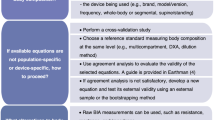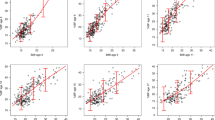Abstract
Background/Objectives:
Bioelectrical impedance analysis (BIA) is widely used to predict body composition in paediatric research and clinical practice. Many equations have been published, but provide inconsistent predictions.
Aims:
To test whether a single equation for lean mass (LM) estimation from BIA is appropriate across wide ranges of age, pubertal status and nutritional status, by testing whether specific groups differ in the slope or intercept of the equation.
Subjects/Methods:
In 547 healthy individuals aged 4–24 years (240 males), we collected data on body mass (BM) and height (HT), and lean mass (LM) using the 4-component model. Impedance (Z) was measured using TANITA BC418MA instrumentation. LM was regressed on HT2/Z. Multiple regression analysis was conducted to investigate whether groups based on gender, age, pubertal status or nutritional status differed in the association of LM with HT2/Z.
Results:
BM ranged from 5 to 128 kg. HT2/Z was a strong predictor of LM (r2=0.953, s.e.e.=2.9 kg). There was little evidence of a sex difference in this relationship, however, children aged 4–7 years and 16–19 years differed significantly from other age groups in regression slopes and intercepts. Similar variability was encountered for pubertal stage, but not for nutritional status.
Conclusions:
No single BIA equation applies across the age range 4–24 years. At certain ages or pubertal stages, the slope and intercept of the equation relating LM to HT2/Z alters. Failure to address such age effects is likely to result in poor accuracy of BIA (errors of several kg) for longitudinal studies of change in body composition.
This is a preview of subscription content, access via your institution
Access options
Subscribe to this journal
Receive 12 print issues and online access
$259.00 per year
only $21.58 per issue
Buy this article
- Purchase on Springer Link
- Instant access to full article PDF
Prices may be subject to local taxes which are calculated during checkout




Similar content being viewed by others
References
Wells JC, Fewtrell MS . Is body composition important for paediatricians? Arch Dis Child 2008; 93, 168–172.
Cole TJ, Bellizzi MC, Flegal KM, Dietz WH . Establishing a standard definition for child overweight and obesity worldwide: international survey. BMJ 2000; 320, 1240–1243.
Cole TJ, Flegal KM, Nicholls D, Jackson AA . Body mass index cut offs to define thinness in children and adolescents: international survey. BMJ 2007; 335, 194.
Daniels SR, Khoury PR, Morrison JA . The utility of body mass index as a measure of body fatness in children and adolescents: differences by race and gender. Pediatrics 1997; 99, 804–807.
Wells JC . A Hattori chart analysis of body mass index in infants and children. Int J Obes Relat Metab Disord 2000; 24, 325–329.
Haroun D, Taylor SJ, Viner RM, Hayward RS, Darch TS, Eaton S et al. Validation of bioelectrical impedance analysis in adolescents across different ethnic groups. Obesity (Silver Spring) 2010; 18, 1252–1259.
Nightingale CM, Rudnicka AR, Owen CG, Cook DG, Whincup PH . Patterns of body size and adiposity among UK children of South Asian, black African-Caribbean and white European origin: Child Heart And health Study in England (CHASE Study). Int J Epidemiol 2011; 40, 33–44.
Jebb SA, Cole TJ, Doman D, Murgatroyd PR, Prentice AM . Evaluation of the novel Tanita body-fat analyser to measure body composition by comparison with a four-compartment model. Br J Nutr 2000; 83, 115–122.
Horlick M, Arpadi SM, Bethel J, Wang J, Moye Jr J, Cuff P et al. Bioelectrical impedance analysis models for prediction of total body water and fat-free mass in healthy and HIV-infected children and adolescents. Am J ClinNutr 2002; 76, 991–999.
Houtkooper LB, Going SB, Lohman TG, Roche AF, Van LM . Bioelectrical impedance estimation of fat-free body mass in children and youth: a cross-validation study. J Appl Physiol 1992; 72, 366–373.
Schaefer F, Georgi M, Zieger A, Scharer K . Usefulness of bioelectric impedance and skinfold measurements in predicting fat-free mass derived from total body potassium in children. Pediatr Res 1994; 35, 617–624.
Cordain L, Whicker RE, Johnson JE . Body composition determination in children using bioelectrical impedance. Growth Dev Aging 1988; 52, 37–40.
Deurenberg P, van der KK, Leenen R, Weststrate JA, Seidell JC . Sex and age specific prediction formulas for estimating body composition from bioelectrical impedance: a cross-validation study. Int J Obes 1991; 15, 17–25.
Davies PS, Preece MA, Hicks CJ, Halliday D . The prediction of total body water using bioelectrical impedance in children and adolescents. Ann Hum Biol 1988; 15, 237–240.
Wells JC, Fuller NJ, Dewit O, Fewtrell MS, Elia M, Cole TJ . Four-component model of body composition in children: density and hydration of fat-free mass and comparison with simpler models. Am J Clin Nutr 1999; 69, 904–912.
Cole TJ, Freeman JV, Preece MA . Body mass index reference curves for the UK, 1990. Arch Dis Child 1995; 73, 25–29.
Freeman JV, Cole TJ, Chinn S, Jones PR, White EM, Preece MA . Cross sectional stature and weight reference curves for the UK, 1990. Arch Dis Child 1995; 73, 17–24.
Taylor SJ, Whincup PH, Hindmarsh PC, Lampe F, Odoki K, Cook DG . Performance of a new pubertal self-assessment questionnaire: a preliminary study. Paediatr Perinat Epidemiol 2001; 15, 88–94.
Chomtho S, Fewtrell MS, Jaffe A, Williams JE, Wells JC . Evaluation of arm anthropometry for assessing pediatric body composition: evidence from healthy and sick children. Pediatr Res 2006; 59, 860–865.
Dewit O, Fuller NJ, Fewtrell MS, Elia M, Wells JC . Whole body air displacement plethysmography compared with hydrodensitometry for body composition analysis. Arch Dis Child 2000; 82, 159–164.
Fuller NJ, Jebb SA, Laskey MA, Coward WA, Elia M . Four-component model for the assessment of body composition in humans: comparison with alternative methods, and evaluation of the density and hydration of fat-free mass. Clin Sci (Lond) 1992; 82, 687–693.
Wells JC, Fuller NJ . Precision of measurement and body size in whole-body air-displacement plethysmography. IntJ Obes Relat Metab Disord 2001; 25, 1161–1167.
Kushner RF, Schoeller DA, Fjeld CR, Danford L . Is the impedance index (ht2/R) significant in predicting total body water? Am J Clin Nutr 1992; 56, 835–839.
Wabitsch M, Braun U, Heinze E, Muche R, Mayer H, Teller W et al. Body composition in 5–18-y-old obese children and adolescents before and after weight reduction as assessed by deuterium dilution and bioelectrical impedance analysis. Am J Clin Nutr 1996; 64, 1–6.
Haroun D, Croker H, Viner RM, Williams JE, Darch TS, Fewtrell MS et al. Validation of BIA in obese children and adolescents and re-evaluation in a longitudinal study. Obesity (Silver Spring) 2009; 17, 2245–2250.
Organ LW, Bradham GB, Gore DT, Lozier SL . Segmental bioelectrical impedance analysis: theory and application of a new technique. J Appl Physiol 1994; 77, 98–112.
Cleary J, Daniells S, Okely AD, Batterham M, Nicholls J . Predictive validity of four bioelectrical impedance equations in determining percent fat mass in overweight and obese children. J Am Diet Assoc 2008; 108, 136–139.
Clasey JL, Bradley KD, Bradley JW, Long DE, Griffith JR . A new BIA equation estimating the body composition of young children. Obesity (Silver Spring) 2011; 19, 1813–1817.
Williams JE, Wells JC, Wilson CM, Haroun D, Lucas A, Fewtrell MS . Evaluation of Lunar Prodigy dual-energy X-ray absorptiometry for assessing body composition in healthy persons and patients by comparison with the criterion 4-component model. Am J Clin Nutr 2006; 83, 1047–1054.
Wells JC, Haroun D, Williams JE, Wilson C, Darch T, Viner RM et al. Evaluation of DXA against the four-component model of body composition in obese children and adolescents aged 5–21 years. Int J Obes (Lond) 2010; 34, 649–655.
Jakicic JM, Wing RR, Lang W . Bioelectrical impedance analysis to assess body composition in obese adult women: the effect of ethnicity. Int J Obes Relat Metab Disord 1998; 22, 243–249.
Going S, Nichols J, Loftin M, Stewart D, Lohman T, Tuuri G et al. Validation of bioelectrical impedance analysis (BIA) for estimation of body composition in Black, White and Hispanic adolescent girls. Int J Body Compos Res 2006; 4, 161–167.
Liu A, Byrne NM, Ma G, Nasreddine L, Trinidad TP, Kijboonchoo K et al. Validation of bioelectrical impedance analysis for total body water assessment against the deuterium dilution technique in Asian children. Eur J Clin Nutr 2011; 65, 1321–1327.
Acknowledgements
Publication of this article was supported by a grant from seca Gmbh & Co. KG, Hamburg, Germany.
Author information
Authors and Affiliations
Corresponding author
Ethics declarations
Competing interests
The authors declare no conflict of interest.
Additional information
Contributors: The study hypothesis was conceived by JCKW, MS and MSF. The data were collected and modelled by JEW and DH, under the supervision of MSF and JCKW. CM undertook the database preparation and statistical analyses, and wrote the first draft of the manuscript. All authors contributed to subsequent revisions of the manuscript.
Rights and permissions
About this article
Cite this article
Montagnese, C., Williams, J., Haroun, D. et al. Is a single bioelectrical impedance equation valid for children of wide ranges of age, pubertal status and nutritional status? Evidence from the 4-component model. Eur J Clin Nutr 67 (Suppl 1), S34–S39 (2013). https://doi.org/10.1038/ejcn.2011.213
Received:
Revised:
Accepted:
Published:
Issue Date:
DOI: https://doi.org/10.1038/ejcn.2011.213
Keywords
This article is cited by
-
Prediction of fat-free mass in young children using bioelectrical impedance spectroscopy
European Journal of Clinical Nutrition (2023)
-
Associations of age and body mass index with hydration and density of fat-free mass from 4 to 22 years
European Journal of Clinical Nutrition (2019)
-
Calibration of bioelectrical impedance analysis for body composition assessment in Ethiopian infants using air-displacement plethysmography
European Journal of Clinical Nutrition (2015)
-
Body composition during growth in children: limitations and perspectives of bioelectrical impedance analysis
European Journal of Clinical Nutrition (2015)
-
Bioelectrical impedance analysis to estimate body composition, and change in adiposity, in overweight and obese adolescents: comparison with dual-energy x-ray absorptiometry
BMC Pediatrics (2014)



